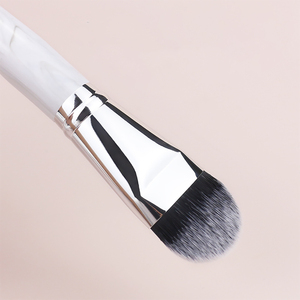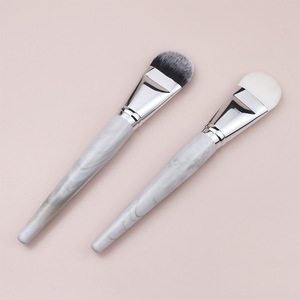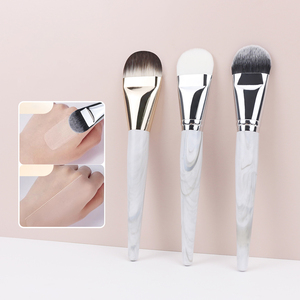(91287 products available)



































 Ready to Ship
Ready to Ship





 Ready to Ship
Ready to Ship



















































































































































































A brush type is a makeup tool for applying and blending makeup products. It has synthetic or natural bristles and an applicator head. The handle is either short or long. Different makeup products have different types of brushes for application. Some of them include:
Foundation brush
It helps to apply liquid or cream foundation. The brush is dense and with a flat head. It is also slightly tapered. The bristles are packed tightly together. This helps to create a smooth finish. The brush is used by sweeping or buffing the foundation onto the face. It leaves no visible brush marks. It is also easy to apply makeup in hard-to-reach areas like the nose and eyes.
Concealer brush
The brush helps to cover dark circles, spots, and blemishes on the face. It is small, firm, and with a rounded tip. This makes it easy to apply concealer in areas under the eyes or around the nose. The brush is also helpful in covering scars or birthmarks. Some concealer brushes have a flat shape and a paddle design. They are used to apply and blend cream or liquid concealer on the face.
Blush brush
The brush helps apply powder blush to the cheeks. It has a large, rounded shape with soft bristles. The bristles are fluffy, which makes it perfect for a light application. The brush offers a natural-looking flush. Some blush brushes have an angled shape. They make it easy to apply blush on the apples of the cheeks.
Eyeshadow brush
The brush is used to apply eyeshadow on the eyelids. It has short and dense bristles. The bristles are firm and packed closely together. This helps to create a smooth and even application of the eyeshadow. Some eyeshadow brushes have a tapered shape. They help to create precise and concentrated color applications in the eye makeup.
Lip brush
This small brush is used to apply lipstick and lip gloss. It helps to create a precise and even application of the lip color. The lip brush has short bristles that are firm and dense. They are sometimes made with synthetic fibers. The brush is helpful for creating a fuller lip or a more defined lip shape. It is also useful for touching up lipstick when on the go.
Brow brush
The brush helps to fill and define the eyebrows. It is small and with firm bristles like the lip brush. The bristles are short and help create more natural-looking eyebrows. Some brow brushes have a spoolie on one end. The spoolie brush combs and grooms the eyebrows. It also blends the eyebrow product for a more natural look.
Choosing the right kind of makeup brush can be daunting. There are many to choose from, and with each type of brush, there are many variations. Here are some tips for choosing the right makeup brushes:
How to use:
Makeup brushes are used for applying makeup products. The user can choose a suitable brush for the product they want to apply. For example, use a foundation brush to apply the foundation. Dab the brush on the product and use it to apply on the face. The same process applies to other makeup products like powder, eyeshadow, and blush. Use a slight hand when applying makeup. The goal is to blend the products into the skin.
Installation:
There is no specific installation for makeup brushes. Users just need to store them in a safe space where they can easily access them. Brush holders are an excellent choice for storing makeup brushes. It keeps them safe and makes them easy to use. Avoid storing the brushes in a closed container as this can damage the bristles. The brushes need to breathe to dry out after cleaning.
Product safety:
Makeup brushes are safe when used correctly. However, they can cause skin infection when used on open wounds. They can also cause skin irritation when used on infected skin. It is advisable to use a separate set of brushes for professional use and personal care. This will reduce the risk of cross-contamination and ensure safety for everyone involved. Clean the brushes regularly to reduce the buildup of makeup products, dust, and bacteria.Every makeup brush has a unique function. Some are meant for applying products, while others are used for blending. Below are the key functions, features, and designs of makeup brushes.
Applying products
Applying brushes are used to apply makeup products such as foundation, powder, eyeshadow, and blush. They are designed to pick up the product and apply it evenly on the skin or blend with other colors. Common applying brushes include flat foundation brushes, angled blush brushes, and eyeshadow brushes.
Blending
Blending brushes smooth out harsh lines and create a seamless finish in makeup application. They blend different makeup products or colors to achieve a natural look. Blending brushes often have fluffy bristles that are soft and dense to blend with ease. Makeup artists use these brushes to blend foundation and concealer. They also use them to blend eyeshadow colors. Common blending brushes include stippling brushes, buffing brushes, and blending sponges.
Detailing
Detailing brushes are small and precise, designed to add or blend makeup in specific areas. They can be used to cover blemishes, contour the nose, or highlight the inner corners of the eyes. Detailing brushes allow for a high level of accuracy and are essential for creating intricate makeup looks. Some common detailing brushes include pencil brushes, small angled brushes, and flat concealer brushes.
Bristle softness
The bristles of a makeup brush can be soft or hard. Soft bristles are fluffy and dense, while hard bristles are firm and short. The bristle's softness affects the brush's application and blending. For example, a soft powder brush has fluffy and soft bristles to apply powder makeup. It won't pick up much product because the bristles are too soft and fluffy.
Handle length and shape
Makeup brushes come in different handle lengths and shapes. Some have short handles, while others are long. The length and shape of the brush handle affect comfort during use. Handles that are too long or short can be uncomfortable to use. Handle comfort also affects precision during makeup application. Makeup brushes with ergonomic handles are more comfortable to use than those with regular handles.
Special features
Some makeup brushes have special features that enhance their performance. For example, makeup brushes with silicone bristles are more durable than those made of natural fibers. They are also easier to clean and dry quickly. Some foundation brush types have LED lights that illuminate when pressed. The lights help users apply makeup in well-lit areas. LED makeup brushes are perfect for professional makeup artists.
Q1: What are the different types of makeup brushes?
A1: There are five essential makeup brushes. They include foundation, powder, contour, eyeshadow, and lip brushes. Each brush is designed to perform a specific function during the makeup application process.
Q2: What is the purpose of a foundation brush?
A2: A foundation brush is used to apply and blend foundation on the face. It ensures an even and smooth application, covering blemishes and other facial imperfections.
Q3: What is the purpose of a powder brush?
A3: A powder brush is primarily used to apply loose or pressed powders to the face. It is designed to absorb and distribute powder evenly across the face for a natural look.
Q4: What is the difference between a contour brush and an eyeshadow brush?
A4: A contour brush has angled or tapered bristles that help apply bronzer or contour products in the hollows of the cheeks, jawline, and nose. On the other hand, the eyeshadow brush is used to apply eyeshadow on the eyelids during makeup application.
Q5: What is the purpose of a lip brush?
A5: The lip brush is used to apply lipstick and lip gloss to the lips. Its small size and density bristles make it ideal for achieving precise and even lipstick application.